 THE
VigilanceVoice
THE
VigilanceVoice
Wednesday... January 9, 2002—Ground
Zero Plus 120

|
GI-Joe's "Sgt. Slaughter" |
GI-JOE VIGILANCE
Is It The Right Tactic To Teach
Our Kids?
by
Cliff McKenzie
Editor, New York City Combat Correspondent News
The pulse of a nation battling Terrorism beats ferociously at FAO Swartz’s famous toy store in New
York City--the store throbs with GI Joe Vigilance.
Yesterday, my wife and I swung by
FAO--our favorite place to take
our grandchildren. We were searching FAO Swartz's limitless toy
inventory for a small replica of Fluffy, the three-headed dog from Harry
Potter. The kids wanted to place Fluffy at the entrance of their
make-believe Paradise. Fluffy's mission: ward off the
dinosaurs who constantly attack Paradise.
Fluffy was to back-up the Prince of Paradise
Land who
stands vigil on his white horse with the Princess at his side.
Fluffy was going to give the Magic Unicorn—the Prince’s current
back-up sentinel—a break.
I had
no idea who Fluffy was. Unfortunately, I left Harry Potter before
the movie ended. I found the story far too slow and not
engaging for my tastes. My wife remained to see the movie to
the end. So I went to the coffee shop across the street near busy
Union Square. I found a window seat looking out on Broadway, jammed with Holiday foot traffic. I had my
digital camera with me and began to shoot candid pictures of passersby gawking into the window, or just walking to some unknown
destination. I pretended I was the late Alan Funt of Candid Camera,
surreptitiously clicking photos of the people outside without their
knowledge.
I've found
that a person’s face is like a book. It reveals the chapters of a happy or
sad life. Some are scribed in wrinkles or smiles, in grimaces or
glows that flow from the forehead to the chin. Some walk with
blank, empty stares--lost souls ambulating down the sidewalk of life.
Others lower their heads defiantly, assuming the attitude of the prow of
an Exxon oil
tanker burrowing through the masses in an angry,
“get-out-of-my-&%#@!@#$-way” tack.
Still others
appear as nervous as mice. Their eyes flicker here or there,
exhibiting meek, intimidated natures. A few walk with
arrogance, heads above the crowd, shoulders back, gliding as though they
were riding in a royal carriage, oblivious to the mass of humanity spilling
around them.
A few walk and laugh
and talk, as comfortably as they might repose in the living room with
friends and sip
champagne. They radiate a joviality that ignores the cold breezes
gusting up the street, or sirens
blaring or “crazy people” yelling at blank air. Combined, they
all make fascinating
pictures and provide me with endless entertainment when I could be bored.
My circuitous
point is—I missed seeing Fluffy in the movie. So, a few weeks later,
as we entered FAO, I had no idea what
a three-headed dog named Fluffy looked like. Little did I know it was scary to
say the least--something a dog-lover like myself might not want to buy for
his grandchildren.
 Inside FAO, we asked for directions
to the Harry Potter display from
one of the smiling employees. “Turn left at the top of the escalator, and then
another left and go straight down and you’ll run right into the Harry
Potter display,” he cheerfully offered.
Inside FAO, we asked for directions
to the Harry Potter display from
one of the smiling employees. “Turn left at the top of the escalator, and then
another left and go straight down and you’ll run right into the Harry
Potter display,” he cheerfully offered.
We took
a wrong turn. Instead of hitting Harry Potter Land, we found
ourselves ambushed by GI-Joe Land.
It was
an awesome display, filling both sides of a narrow pathway between two
main sections of the store.
GI-Joe
glass-encased displays rose from the floor to the ceiling. Each exhibited
different uniforms and configurations of warriors in fierce battle with
the enemy. There were jungle scenes, desert
scenes, mountain scenes, sea scenes and snow battles. GI-Joe was kicking everyone’s
butt. In one, GI-Joe characters were assaulting a town, throwing hand
grenades into buildings, shooting flame throwers, blasting machine guns,
firing rocket launchers.
town, throwing hand
grenades into buildings, shooting flame throwers, blasting machine guns,
firing rocket launchers.
Another display showed Special Forces GI-Joes. They were
“kung-fuing” the bin Laden boys—high kicking them in the face, throwing
them on the ground, stomping them.
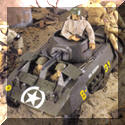 GI-Joes were not without air support. Suspended above the
GI-Joes were helicopters with massive armament—rockets, machine guns,
troops inside—blazing away at the enemy on the ground. Some of the
helicopters I had never seen before. They were super high-tech. Others I
remembered from my Vietnam days—ancient stand-by “warrior ships” that
ferried us in strike forces from one battle to another, hovering overhead
to lay fire on the enemy, or swooping in to extract us.
GI-Joes were not without air support. Suspended above the
GI-Joes were helicopters with massive armament—rockets, machine guns,
troops inside—blazing away at the enemy on the ground. Some of the
helicopters I had never seen before. They were super high-tech. Others I
remembered from my Vietnam days—ancient stand-by “warrior ships” that
ferried us in strike forces from one battle to another, hovering overhead
to lay fire on the enemy, or swooping in to extract us.
Personally, I loved war. As a kid, I grew up playing war as my
perennial pastime. Outdoor games were almost always the “good
guys” versus the “bad guys.” It was society's pre-pubescent
training to become a man—training to learn to kill
without compunction. Toy guns were common gifts, and the better the
gun, the more status you earned with your buddies because the more of them
you could "pretend kill." My GI-Joe training stuck with me.
I
joined the Marine Corps because if I was going to war, I wanted to be with
the finest warriors. I learned my trade well. But after coming
back from Vietnam, and being spat upon, and derided and demeaned for being
a "baby killer," I placed my "warrior nature" on hold. America
became a land of "flower children." America's attitude toward war
continued to be negative. Political correctness swallowed patriotism as we
shoved Pearl Harbor into the background and apologized to the Japanese.
Desert Storm didn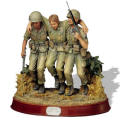 't last long because it was a high-tech "surgical war"
fought in 100 days. Following its success, the citizenry voted out
the commander-in-chief for a "I-feel-your-pain leader" who sold vital
computer data to China on the promise they wouldn't use it to deliver ICBM
missiles within six-feet of their target. We started to dismantle
our military, reducing it so that it could only fight one war on one front, versus its previous ability to fight two conflicts at
the same time.
't last long because it was a high-tech "surgical war"
fought in 100 days. Following its success, the citizenry voted out
the commander-in-chief for a "I-feel-your-pain leader" who sold vital
computer data to China on the promise they wouldn't use it to deliver ICBM
missiles within six-feet of their target. We started to dismantle
our military, reducing it so that it could only fight one war on one front, versus its previous ability to fight two conflicts at
the same time.
I was sure America had buried primal warrior training in its political
correctness--in its eagerness to be the "global good guy versus the
world's policeman." I figured GI-Joe was dead and buried by Jane
Fonda and her anti-war buddies.
That
is, until I walked into FAO Swartz the other day.
As I grew older and my grandchildren were born, I began to see
the need to teach a child something more than how to “kill” to be a
“man.” My thirst for blood was replaced by a deeper need
to find resolution versus revenge against those who had harmed me. Human emotional strength of character became, in my mind,
a more important
measure of manhood than the ability to cut someone’s throat, or sink a
bayonet in the enemy's guts and twist it to inflict maximum damage.
Since
my older daughter and her husband are anti-violence
advocates and active protesters for peace, I reluctantly set aside my history of being
a living GI-Joe. I learned there were other ways to evaluate a
man than by measuring his ability to run through the gauntlet of violence
unscathed. I learned to respect human “character.”
So it was that a Harry Potter "Fluffy" watchdog
was about as violent a toy as I had in mind for my grandson and
granddaughter.
As I walked down the
rows of GI-Joes displays at FAO, I realized America had
adopted a new Sentinel of Vigilance—a
toy—an action figure—a symbol of violence. I felt time reversed
itself, racing back to the days when I was a young boy, just after World War II, when everyone I
knew played "how to kill."
My wife, an aficionado of war and combat, glued herself to the
displays as I tried to ignore them. She loves war, and studies the history of it far more than I
do. She often says she wishes she could have been a man and fought in one—a
throwback to her upbringing where “women were women” and “men were men.”
“Cliff, look at this. Wow!” She kept calling me back to
examine the intricacies of the tanks, the mortars; to admire the reality
of each figure and the collateral war equipment articulately placed in
each of the various displays.
My
angst for war was partly my own fault. For the past year I had been
working on my memoirs about Vietnam, reliving the battles and grueling
memories of the often senseless killing of people.
I had described in detail the twists of human character that war delivers
upon the young men who fight it, and how the "Beast of Terror" consumed
many, turning them into vicious beasts of violence. Ashamedly, I
admitted how I had been consumed by the "beast of Terror" against my will.
So, I looked upon the displays as scenes of
horror—tools to teach young boys that the ideal "manhood achievement" in life was to kill.
Having
“killed” in real life, and
 experienced a life-long sense of remorse that
the reason I took lives wasn't as justified as I had once thought it was, I
was disturbed by what the displays represented. I had
no desire to teach my grandson the glory of killing, or to consider that
employing violence was a measure of manhood. I had learned the hard
way that manhood meant many other things than driving a bullet into an
enemy's heart.
experienced a life-long sense of remorse that
the reason I took lives wasn't as justified as I had once thought it was, I
was disturbed by what the displays represented. I had
no desire to teach my grandson the glory of killing, or to consider that
employing violence was a measure of manhood. I had learned the hard
way that manhood meant many other things than driving a bullet into an
enemy's heart.
What
bothered me the most about the displays, was the idea parents were eager
to teach their children that vigilance against Terrorism is gauged by the
barrel of a gun. From my own experience, I knew that manhood
comprised much more than racking up “kills.” Yet, as I looked
at the renewal of the GI-Joe displays, I sensed that America had found a
new way to feel secure—and that was to give its children toys of
violence--to teach them "killing was okay!"
And why not?
As I thought about it, the single goal of America over the past four
months has been to cut bin Laden's head off and roll it down Pennsylvania
Avenue. Why wouldn't a child want to be part of America's constant
search and destroy mission to "kill evil?" It was macabre
thought, but a reality I was forced to face by the presence of GI-Joes.
Killing was now politically correct. At least, killing bin Laden
was. And, if we could kill bin Laden, why not anyone else who
challenged us? GI-Joe was right on schedule.
When I got home, I ran to my computer and Googled GI-Joe.
(Google
is a search engine I use that gives me instant sources of information).
I wanted to know as much about him as possible. The Hasbro character of GI-Joe was first introduced in 1964. He stood 12
inches high and had 21 moveable parts. He was tough, with a scar on his
right cheek to show he was a hand-to-hand combat vet. He was named after
a 1945 movie, The Story of GI Joe, starring one of my favorite
actors, the late Robert Mitchum.
As the anti-war tides rose in the 70’s, Hasbro shifted the
GI-Joe character into more action roles, making him an adventure figure
exploring deep into jungles or space rather than a "nasty war-monger." He rose to become the “King of
Action Figures,” rivaling Barbie as the “Queen of Beauty.”
Now, thirty years later, he’s back in top killing form. But,
I fear a danger in his presence. I fear a child might dilute the true
meaning of vigilance by embracing the false power of violence GI-Joe
represents..
Instilling vigilance in a child is not about teaching violence.
It is about teaching character. Character is the greatest
shield against any enemy—including Terrorists who threaten a child’s
physical and emotional security.
Violence, per se, is a retaliatory force against fear. When
“fear” strikes, a human being faces two choices—“fight” or “flee.”
However, there is another choice often overlooked. It is “standing up
for what you believe!” Another word for it is "courage."
Terrorism brings to us the
ability to
deal with fear, intimidation and complacency as we never have before. Unlike a conventional
enemy, Terrorism attacks our emotional well-being. It permeates our way
of life like a dark cloud hanging over our heads, constantly shifting and
changing with the wind so that we can’t put our hands around it, or corral
it, or envelope it as we might an aggressor nation where the geography
would allow us to “invade” its homeland and quash its leadership as we did
against Germany and Hitler in World War II.
Terrorism is an attitude.
It must
be fought at the roots of its being by addressing its most powerful
weapons-- “fear,”
“intimidation,” and “complacency.”
If we
are honest about what Terrorism’s real threats are, they are not guns or
bullets or bombs or airliners smashing into the Twin Towers or the
Pentagon, but rather a set of emotional booby traps that ignite and
incense our “internal emotional security.” Terrorism's venom makes us feel
“unsafe.”
It creates
insecurity and confusion because we have no real defense against
Terrorism. We cannot protect ourselves from a 15-year-old
disturbed young boy who flies his Cessna into a building. We
cannot protect ourselves from a madman who fills a van full of fertilizer
and blows up a federal building in Oklahoma City. We can’t
protect ourselves from a person who straps a bomb around his or her waist and climbs on a bus and blows up people. Or,
defend ourselves from a maniac who
laces letters with anthrax.
Individual acts of human destruction are indefensible. No one
can predict when a Charles Whitman will climb up on a tower and start
shooting people. Or, when some drug-crazed person will shoot
someone for ten dollars to get money for a fix, or, at what precise time
or place a disgruntled employee will
walk into a post office or McDonald's and start “taking
out” everyone.
 GI-Joe suggests we can protect ourselves with violence..
GI-Joe implies that if we arm ourselves with enough bullets, guns, tanks,
helicopters, hand grenades, and put a scar on our right cheek, we will
ward off “evil.”
GI-Joe suggests we can protect ourselves with violence..
GI-Joe implies that if we arm ourselves with enough bullets, guns, tanks,
helicopters, hand grenades, and put a scar on our right cheek, we will
ward off “evil.”
That’s the rub.
That’s the danger.
While vigilance certainly doesn’t discount the need for a
person to be able to defend himself or herself by learning how to “fight”
another in self-defense, it certainly doesn’t suggest that violence in and
of itself
is the solution.
All
wars are finally won not on the battlefield, but at the negotiating table.
When the smoke clears and the bodies are counted, sanity returns.
Humans stop killing and start talking. Sometimes that talking
is forced by the killing, as it was in the case of the atomic bomb dropped
on Japan. Other times the negotiating is driven by the
relentless waste of human resources, where neither side wins or loses the
battle, but instead tires of the destruction and chaos of war.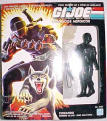
Angry
human beings yelling at each other in domestic disputes reach a point
where vitriolic emotions no longer serve any purpose
and, if the parties don't kill each other in the process, they tire of the battle. Then,
they sit down either in a counseling session or
with divorce lawyers to negotiate a settlement of differences.
This is where the GI-Joe syndrome loses it punch. It shows a
child that violence is a solution, while ignoring the fact that violence
is only a step toward a solution—and often, an unnecessary step.
With Terrorism, violence serves little to resolve its core
issue. If we believe that Terrorism is an “emotional assault” on the
“character of our being,” then guns and bullets and bombs have little to
do with the resolution of it.
Vigilance for children and families in today’s climate of Terrorism is
best battled not with GI-Joe figures, but with the Pledge Of Vigilance.
Under the principles of the Pledge, a parent or loved one takes on added
responsibility to protect the child from "emotional" as well as "physical
harm." Essentially, the parents' job under the Pledge is to
become a "character coach," helping the child build
strength from within.
If parents seek an
effective way to teach their children to defend themselves against
Terrorism, they must accept and address the weapons of
Terrorism—“fear,” “intimidation” and “complacency.”
The Pledge of Vigilance provides “weapons” to counter
Terrorism’s destructive tools. They are: 1.) “Courage to stand up for
what you believe versus the fear of running from it.” 2.) The
“Conviction to weather the storms of fear and intimidation when it seems
that they overpower you.” And, 3.) The “Action necessary to to
resolve the issues and grow from the experience rather than be demeaned or
marginalized by it.”
In a nutshell,
the Pledge of Vigilance is about emotional evolution. Its tenants
teach a child to not be afraid of the unknown--to stand up for
what he or she believes, despite pressures from peer groups to “go along
with the crowd.” And, it promotes taking actions to validate those
beliefs, so they become realities within the child rather than illusions
or unreachable fantasies. Human character growth replaces the
need to have a gun or "kill" to be a "real man" or a "real woman.."
Of
course, it is easier to buy a toy and placate ourselves we are teaching
our children vigilance than to take Pledge of Vigilance and promote the principles of Semper Vigilantes--Always Vigilant.
Character building requires we build our own in conjunction with our
child's. That is a lot to ask of people who would prefer to
buy "character" at a toy store in the form of a GI-Joe. The
problem is, "character" is not for sale.
I don't
believe the victims of Nine Eleven would argue that point. If they died for a reason, it wasn’t revenge. To avenge
their deaths provides them no solace. Vengeance only pours blood on blood.
It leaves no valued legacy for our children or our nation to build upon.
I believe the victims of Nine Eleven sacrificed their lives so
that we might all learn more about the true meaning of Vigilance. I
believe they--all whose bodies are buried under the heaps of rubble and
twisted metal--want us to learn to turn fear into courage, intimidation
into conviction, and complacency into action.
I don't think they
want us to buy GI-Joes for our children.
Instead, I believe
they want us to take the Pledge Of Vigilance. They want the value of
their death to live for generations through a new and clearer
understanding of Vigilance--through the evolution of character.
I also
believe if we as Parents of Vigilance
take the Pledge, the victims of September 11th will have died for a great reason—to teach us
how to build more character in our children, and, as a result, how to evolve as stronger
human beings who become “fearless” in the face of any enemy.
I don’t think those who died on September 11 would give their
children or yours a GI-Joe to remember them by. They would prefer a legacy
of Vigilance to be passed on rather than one of violence.
.
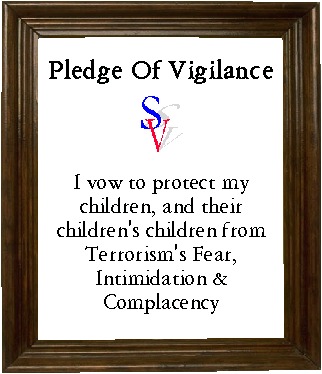

Go
To Daily Diary, Jan. 8--ADOPTING MAYOR RUDY AS MY FATHER OF VIGILANCE
©2001
- 2004, VigilanceVoice.com, All rights reserved - a ((HYYPE))
design
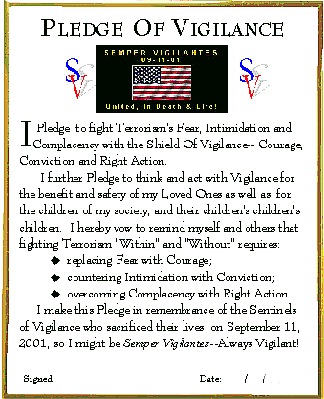



 town, throwing hand
grenades into buildings, shooting flame throwers, blasting machine guns,
firing rocket launchers.
town, throwing hand
grenades into buildings, shooting flame throwers, blasting machine guns,
firing rocket launchers. GI-Joes were not without air support. Suspended above the
GI-Joes were helicopters with massive armament—rockets, machine guns,
troops inside—blazing away at the enemy on the ground. Some of the
helicopters I had never seen before. They were super high-tech. Others I
remembered from my Vietnam days—ancient stand-by “warrior ships” that
ferried us in strike forces from one battle to another, hovering overhead
to lay fire on the enemy, or swooping in to extract us.
GI-Joes were not without air support. Suspended above the
GI-Joes were helicopters with massive armament—rockets, machine guns,
troops inside—blazing away at the enemy on the ground. Some of the
helicopters I had never seen before. They were super high-tech. Others I
remembered from my Vietnam days—ancient stand-by “warrior ships” that
ferried us in strike forces from one battle to another, hovering overhead
to lay fire on the enemy, or swooping in to extract us. 't last long because it was a high-tech "surgical war"
fought in 100 days. Following its success, the citizenry voted out
the commander-in-chief for a "I-feel-your-pain leader" who sold vital
computer data to China on the promise they wouldn't use it to deliver ICBM
missiles within six-feet of their target. We started to dismantle
our military, reducing it so that it could only fight one war on one front, versus its previous ability to fight two conflicts at
the same time.
't last long because it was a high-tech "surgical war"
fought in 100 days. Following its success, the citizenry voted out
the commander-in-chief for a "I-feel-your-pain leader" who sold vital
computer data to China on the promise they wouldn't use it to deliver ICBM
missiles within six-feet of their target. We started to dismantle
our military, reducing it so that it could only fight one war on one front, versus its previous ability to fight two conflicts at
the same time. experienced a life-long sense of remorse that
the reason I took lives wasn't as justified as I had once thought it was, I
was disturbed by what the displays represented. I had
no desire to teach my grandson the glory of killing, or to consider that
employing violence was a measure of manhood. I had learned the hard
way that manhood meant many other things than driving a bullet into an
enemy's heart.
experienced a life-long sense of remorse that
the reason I took lives wasn't as justified as I had once thought it was, I
was disturbed by what the displays represented. I had
no desire to teach my grandson the glory of killing, or to consider that
employing violence was a measure of manhood. I had learned the hard
way that manhood meant many other things than driving a bullet into an
enemy's heart.

 GI-Joe suggests we can protect ourselves with violence..
GI-Joe implies that if we arm ourselves with enough bullets, guns, tanks,
helicopters, hand grenades, and put a scar on our right cheek, we will
ward off “evil.”
GI-Joe suggests we can protect ourselves with violence..
GI-Joe implies that if we arm ourselves with enough bullets, guns, tanks,
helicopters, hand grenades, and put a scar on our right cheek, we will
ward off “evil.”


